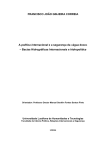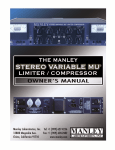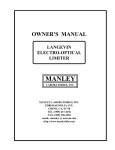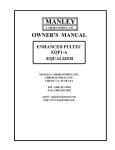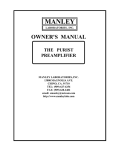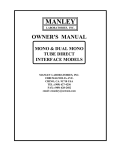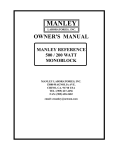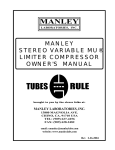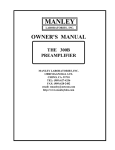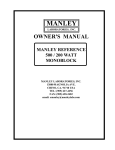Download Manley Mono Owner`s manual
Transcript
MANLEY LABORATORIES, INC. OWNER'S MANUAL MONO "VARIABLE-MU" LIMITER / COMPRESSOR 5670 MODELS MANLEY LABORATORIES, INC. 13880 MAGNOLIA AVE. CHINO, CA. 91710 TEL: (909) 627-4256 FAX: (909) 628-2482 email: [email protected] CONTENTS SECTION PAGE INTRODUCTION 3 MAINS CONNECTIONS 4 INSTALLATION 5 FRONT PANEL 6 REAR PANEL 7 OPERATIONAL NOTES 8 TECHNICAL NOTES 9 TYPICAL SETTINGS 10 SERVICE ADJUSTMENTS 11 SPECIFICATIONS 12 WARRANTY 13 WARRANTY REGISTRATION 14 INTRODUCTION THANK YOU!... for choosing the Manley Laboratories Mono Variable-MU Limiter Compressor Amplifier. The heart of this limiter is the unique 5670 variable-mu vacuum tube which can handle a widely varying range of input signals in a rapid-acting manner without introducing harmonic distortion. This limiting circuitry was designed by David Manley over thirty years ago. Our current version of this 1960s design combines that classic sound with the precise cleanliness of modern componentry. Please take a few moments to read through this manual, there may be features and information about this unit that are unfamiliar to you. Thank you again, and please enjoy! GENERAL NOTES LOCATION & VENTILATION The Limiter Compressor Amplifier must be installed in a stable location with ample ventilation. It is recommended, if this unit is rack mounted, that you allow enough clearance on the top and bottom of the unit such that constant movement of air can flow through the ventilation holes. There are 4 tubes inside this unit so it does run quite hot. Good ventilation is definitely encouraged. WATER & MOISTURE As with any electrical equipment, this unit should not be used near water or moisture. SPECIAL NOTES Tubes may become loose during transit. Straighten and press down each tube before plugging this unit into the mains socket. Furthermore, don't touch the tubes after the unit has been switched on, the tubes become very hot during operation and should only be handled after the power has been turned off and the tubes have cooled. WARNING! ! TO PREVENT THE RISK OF ELECTRIC SHOCK DO NOT OPEN THE CABINET REFER SERVICING TO QUALIFIED PERSONNEL MAINS CONNECTIONS Your unit has been factory set to the correct mains voltage for your country. The voltage setting is marked on the serial badge, located on the rear panel. Check that this complies with your local supply. Export units for certain markets have a moulded mains plug fitted to comply with local requirements. If your unit does not have a plug fitted the coloured wires should be connected to the appropriate plug terminals in accordance with the following code. GREEN/YELLOW BLUE BROWN EARTH NEUTRAL LIVE terminal terminal terminal As the colours of the wires in the mains lead may not correspond with the coloured marking identifying the terminals in your plug proceed as follows; The wire which is coloured GREEN/YELLOW must be connected to the terminal in the plug which is marked by the letter E or by the safety earth symbol or coloured GREEN or GREEN and YELLOW. The wire which is coloured BLUE must be connected to the terminal in the plug which is marked by the letter N or coloured BLACK. The wire which is coloured BROWN must be connected to the terminal in the plug which is marked by the letter L or coloured RED. DO NOT CONNECT/SWITCH ON THE MAINS SUPPLY UNTIL ALL OTHER CONNECTIONS HAVE BEEN MADE. INSTALLATION Please refer to the REAR PANEL section for a full layout of the rear panel of your Mono limiter compressor. 1. Set the voltage change-over switch on the back of the unit to the voltage you are using. 2. Be certain that the unit has a 1 Amp SLO-BLO (120 Volt operation) fuse. 3. Connect the input signal(s) to the 3 pin female XLR's on the rear panel. The input XLR's are TRANSFORMER COUPLED balanced wired as follows: PIN 1: GROUND PIN 2: (+) POSITIVE GOING PHASE PIN 3: ( - ) NEGATIVE GOING PHASE 4. Connect a 3 pin XLR cable to the male output XLR on the rear panel. The output XLR is balanced and the pinout is wired as follows: PIN 1: GROUND PIN 2: (+) POSITIVE GOING PHASE PIN 3: ( - ) NEGATIVE GOING PHASE The output impedance is 600 Ohms. 5. Connect a standard IEC mains cable to the IEC mains socket on the rear panel. 6. Check that the power is switched off on the unit. 7. Connect the IEC mains cable to a 50/60 Hz AC source of the proper selected voltage. 8. Power up the unit and allow it enough time to stabilize before using (approx 15 to 30 minutes). FRONT PANEL INPUT IN THRESHOLD RECOVERY LIMIT SLOW ATTACK OUTPUT POWER MANLEY • MED 10 dB LIMITER COMPRESSOR MONOBLOCK • BYPASS COMPRESS MIN A B C MAX METER D E F FAST HANDCRAFTED IN CHINO, CALIFORNIA U.S.A. SLOW FAST G H I J A IN / BYPASS Switched in bypass mode, (down position) all effects of the limiting circuitry are bypassed and will not affect the audio signal. In the bypass mode , the audio signal passes from the input directly to the output. B. INPUT Continuously variable attenuation of input signal entering the amplifier limiting circuitry. Full attenuation occurs at the fully counterclockwise position. This control is active only in IN mode. C. COMP. / LIMIT Selects compression ( 1.5:1) or limiting (3:1) function. D. THRESHOLD Continuously variable gain reduction threshold control. Determines the necessary amplitude for compression or limiting to take effect. Most extreme effect is at the MIN (fully counter clockwise) position. The lower the threshold, the more that gets limited. E. METER Factory calibrated. Adjusts zero indication on meter. F. RECOVERY Recovery times can be selected between a. VERY SLOW 8 seconds b. SLOW 4 seconds c. MEDIUM .6 seconds d. FAST .4 second e. VERY FAST .2 second G. ATTACK Continuously variable sensitivity of transient detection. Determines the necessary length of transient to initiate gain reduction. Fast =25mS, Med =50mS, Slow =70mS. Fully counter clockwise at the slowest setting will prevent most percussive signals from causing limiting or compression. H. OUTPUT ATTENUATE Continuously variable attenuation of output signal leaving the amplifier circuitry. Full attenuation occurs at the full counterclockwise position. This control is active only in IN mode. J. GR METER Measures in decibels amount of reduction K. POWER ON/OFF Power is supplied to the unit when switched UP. LED will illuminate REAR PANEL A B C D E F A IEC MAINS SOCKET Standard 3 pin AC mains socket. See the section MAINS CONNECTIONS for more details. B FUSE HOLDER Houses a standard 1 Amp SLO-BLO fuse. Replace only with the same type and size. C GROUND TERMINALS Separate terminals for CIRCUIT (audio) GROUND and CHASSIS (AC) GROUND. Typically these should be joined with the flat jumper supplied. Hum problems or various grounding options are available by different connections to these terminals. D OUTPUT XLR 3 Pin male XLR BALANCED. E LINK TERMINAL Using two units for stereo it is recommended that these terminals be joined. This "LINKS" the units and both will reduce gain by the same amount. Use similar settings for best results. E INPUT XLR 3 Pin female XLR BALANCED. Pin 1 - Ground Pin 2 - Positive going phase (+) Pin 3 - Negative going phase (-) Pin 1 - Ground Pin 2 - Positive going phase (+) Pin 3 - Negative going phase (-) TUBE LAYOUT COMP ZERO 12AL5 12BH7 12AX7A 5670 BALANCE DISTORTION TRIM METER CAL OPERATION NOTES The "MANLEY MONO VARIABLE MU LIMITER - COMPRESSOR" is designed for multiple purposes. The unit can be used as half of a stereo pair by using the link terminal on the back. It can be used as a balanced line amp capable of 30 db! of gain and as a pre-amp for low level signals. Watch your levels with this unit as UNITY GAIN is not with all knobs pointing up. With higher input gain settings the unit can be used to create tube distortion if desired. Modest settings will often enhance the signal in ways difficult to describe however the range includes "tube warmth", richness and enhanced clarity and magic. The attack and recovery controls are important to understand. The response to transients and percussive sounds are affected by the attack control. Recovery is the time it takes for the gain to return to normal. This is called "RELEASE" on some limiters. We can use a typical mix with dynamic vocals, drums and bass for an example. With this example a fast attack setting will react to the drums and reduce the overall gain. If the recovery is very fast then the gain will return to normal quickly. This will have an audible effect of reducing some of the level and attack of the drums in the mix. As the recovery is set slower the gain changes that the drums cause might be heard as "pumping". Now these gain changes caused by the drums are pulling down vocals, some bass and causing volume changes. Slower recovery settings will usually keep the gain changes more inaudible but will also lower the perceived volume. A slow attack setting will tend to ignore drums and other fast signals but will react to the vocals and bass in our example. A slow attack might also let a hard kick drum transient distort the next piece of equipment in the chain. We have set up the unit so that medium settings of both controls provide good gain control and little change in mix values. LIMITING OR COMPRESSION Two basic rules of thumb with any compressor or limiter should be reminded. Typical amounts of gain reduction shown by GR meter should be 2 to 8 dB. The more that the needle swings the more likely the gain changes will be audible. Listen for objectionable "pumping" with fast settings. The original name for this design was the "10 dB Limiter" because up to 10 dB of gain reduction still sounded good however the device can limit 15 to 20 dB depending on the sound. The second name was the 10 dB Limiter / Compressor because we added a compressor switch and the final name was the Variable MU Limiter / Compressor because that is a technical term for the method of gain reduction. Around the factory we call it the LIMCOM. Use your ears to determine optimum settings, not just the meters. Some limiters add unpleasant artifacts with any reasonable looking setting. This limiter may give some magic at unexpected settings. It may help to use the bypass switch to compare the original input with the processed output to verify that an improvement is real. Then, because the peaks are reduced, the final output can be adjusted a little louder that the input. It should be borne in mind that the intended usage, and function therefore, is very different between limiting and compression. In limiting mode we are seeking to control PEAK overshoots or the 'ceiling' level as inaudibly as possible, normally in the 2 to 6 dB area. By using compression we seek to "fold in" a ratio of, say, 20 or 30 dB into 10 dB. Both limiting and compression produce the effect of increasing both the dynamic and average levels - depending on the degree or amount of limiting / compression used. Because dynamic range and peaks can be reduced, often overall loudness can be increased at the output. This is called GAIN MAKE-UP on some compressors and is simply the OUTPUT ATTENUATOR with this unit. Limiters often are designed for very fast attack times only. This assumes that the unit will almost always be used to prevent electronic clipping or overload. Typically the release with these is slow to prevent audible damage to the mix. With this unit you can adjust the attack, release and even the overload point in musical ways. Distortion can be creatively used by turning up the INPUT and turning down the OUTPUTs while using very little or no COMPRESSION. The cleanest settings are easiest to set up and most recommended. Set the THRESHOLD near "MIN", set the ATTACK near "FAST" and adjust the INPUT for 4 to 6 dB of LIMITING, then adjust the OUTPUTS to reach the levels you want or by comparing with BYPASS. Compression with this unit begins at the same threshold so to achieve similar amounts of gain reduction you may have to turn up the INPUT or turn the THRESHOLD to "MIN". TECHNICAL NOTES SWITCHING ON The power switch is located on the right hand corner of the front panel. Flip the switch up to turn on the Limiter Compressor and down to turn off. Do not do this up and down rapidly - could cause damage. TUBE LIFE As with all tubes, their quality degrades with age. This is due to cathode emission, a natural process found in all tubes. We recommend that you have your unit checked every 4-5 years, depending on usage. One symtom of failing tubes is increased noise floor, another is microphonics. NOTE Allow this unit to sufficiently 'warm up' before operating. This unit employs solid state rectification and reaches optimum operation within 30 minutes. Furthermore, any adjustments such as meter calibration should be performed when the unit has sufficiently 'warmed up'. OPERATION The principle of operation of this unit is based around a 5670 variable-mu (variable gain) double triode operating in a fully balanced or symmetrical circuit. Because of the need to preserve symmetry, a balance-adjustment pre-set potentiometer is placed on the vertical circuit board adjacent to the 5670 variable-mu double triode. This control is set so that the two individual triodes amplify equally. (See Adjustments Section). The benefits of utilizing a variable-mu vacuum tube as the 'heart' of the limiting (or compression) function is that a widely varying range of input signals can be handled in a rapid-acting without introducing harmonic distortion - unless the operator / engineer wishes to do so for creative reasons. As with all compressor limiters there will be little change of gain reduction with various settings of ATTACK and RELEASE controls using a sine wave source. With music there will be changes in the amount of gain reduction with changes of these controls. HUM This unit is meant to use the third pin of the mains as the ground reference. The GROUND TERMINALS are one method to reduce hum. Verify that the two terminals are connected with the ground strap or that the hum is less with the strap off one terminal. If all else fails try a three pin to two pin AC adapter rather than break off the AC ground pin. More than likely it is the input/output cabling at fault. Transformer isolated balanced inputs and outputs are most immune to ground problems. These balanced inputs and outputs will interface to unbalanced inputs and outputs automatically. This is a prime benefit with transformers. Alternative ground schemes are common in studios. The two most used are the "textbook style" where cutting shields at either inputs or outputs to prevent ground loops and the "star style" of not using any AC grounds but supplying a separate ground wire from a central ground to each piece of gear. The textbook style could either rely on CHASSIS GROUND being connected to CIRCUIT GROUND with the supplied strap or get its ground from the rack rails. The supplied strap is safer. The star ground method would likely require not using the strap and the CIRCUIT GROUND is connected to the ground wire with a "U" or "#10 fork" crimp. CHASSIS GROUND may be connected to the rack rails deliberately or not. There are other variations that sort of work too. It is likely that this unit will be the least headache because of: A) low current draw, B) transformer isolated & balanced ins and outs, C) the grounding options available with the terminals, D) low input and output impedance. Note however that the low input impedance may be a difficult load for cheap IC based gear. Less "headroom" or more distortion would be a symtom. The "cure" - use "pro" gear (designed to drive 600 ohms) to drive this unit. Another source of hum can be equipment stacked on top of one another. This is not a good plan from the ventilation standpoint generally and it is likely to introduce hum, buzz or noise into the system. Certain gear radiates magnetic fields or high frequency noise around its chassis and other gear may be prone to receiving these fields. Distance helps greatly. This is often worth a try. SERVICE ADJUSTMENTS These are factory presets. These should only be altered after a re-tube. A METER (FRONT PANEL TRIM) - Set in Limit Mode 1. The LIMITER COMPRESSOR is factory calibrated and you should not re-adjust these trims unless you have re-tubed the unit or you suspect that the unit is in need of a "cal". The unit will need to be warmed up for at least an hour to adjust any of these trimmers. AC power fluxuations can affect the meter calibrations. 2. With no signal or gain reduction - adjust the trimmer for a GR meter reading of "0". You may have to adjust again if you go further with these trims. 3) There is a mechanical adjust on the back of the meter to set the rest position counter-clockwise (power should be off). This should align to the furthest line past "12" or fully counter-clockwise on the marked scale. B. This adjusts internal balance and lowest distortion: NOTE: This unit has been factory set for the lowest THD and optimum AC balance. It is recommended that this control be reset only after changing 5670 tubes. Because of high voltages (400 DC volts) in the unit and the necessity of having the unit "ON" while adjusting , we recommend that these procedures be done by a qualified technician with the right tools. We don't want to get our customers shocked. We need you. 1. Adjusting this control adjusts the current draw of the 5670 cathodes. 2. Set a multimeter to read DC volts. 3. Connect a good DC voltmeter to the two 500R resistors (brown, black, brown, brown, green) near this trimmer. The sides of the resistors to measure are not joined to the middle ground trace. 4. Adjust the small trim pot until the VOLTMETER nulls to zero. 5. Alternatively use a distortion meter, 1kHz oscillator, 2 dB of gain reduction and adjust for lowest distortion through the unit. C COMPRESSOR ZERO 1. Step "A" must be checked and OK first. 2. Switch to COMPRESS with no input or gain reduction. 3. Adjust for "0" on the meter. D METER CAL 1. Supply the unit with 1kHz tone and use an extenal meter at the output to measure the output level in dB or AC volts. 2. Turn the THRESHOLD to read 6 dB less output level or 1/2 the voltage as seen on your external meter. 3. Adjust the meter cal trim for 6 dB shown on the front panel meter. 4. Check & Repeat steps A, B, C, D because of interaction of the trims. SPECIFICATIONS Electronics Transformer Input, 3 dual triodes in balanced symmetrical variable mu circuit / line amp and Transformer Output per channel. Vacuum tube audio rectification for side chain. Custom Meters, Attenuators, etc. Input and output transformers designed by David Manley and wound inhouse at Manley Lab's magnetics department. Input Impedance 600 ohms Balanced, PIN 2 HOT Output Impedance 600 ohms Balanced, PIN 2 HOT Gain 3O dB Minimum, 35 dB typical (line amplifier) Maximum Input +36 dB (52 V RMS) (estimated for 1% THD) Input attenuator is before input transformer GR Thresholds Onset of LIMIT -20 dBM to +10 dBM (input at 9:00) Onset of COMPRESS -10 dBM to +10 dBM " Maximum Output +30 dB (26 V RMS) (26 dB headroom) Output attenuator is T pad after Output Transformer Noise Floor -80 dB : 20Hz to 80Khz: -90 dB typical Distortion .1 % at unity gain 100 Hz to 3 Khz typical .2 %: 20Hz to 10Khz at typical settings Frequency Response +/- 1dB from 20 Hz to 20 Khz Recovery Time .2 sec , .4 sec, .6 sec , 4 sec , 8 sec Attack Time 25 ms (Fast) (50 mS at 12:00) to 70 ms (Slow) Applications Professional audio recording, mixing and mastering. Power Consumption 48 watts Fuse type: 1 Amp slo-blo WARRANTY All Manley Laboratories equipment is covered by a limited warranty against defects in materials and workmanship for a period of 90 days from date of purchase to the original purchaser only. A further optional limited 5 year warranty is available to the original purchaser upon proper registration of ownership within 30 days of date of first purchase. Proper registration is made by filling out and returning to the factory the warranty card attached to this general warranty statement, along with a copy of the original sales receipt as proof of the original date of purchase. Only 1 card is issued with each unit, and the serial number is already recorded on it. If the warranty registration card has already been removed then this is not a new unit, and is therefore not warranted by the factory. If you believe this to be a new unit then please contact the factory with the details of purchase. This warranty is provided by the dealer where the unit was purchased, and by Manley Laboratories, Inc. Under the terms of the warranty defective parts will be repaired or replaced without charge, excepting the cost of tubes. No warranty is offered on tubes, unless: 1. a Manley Laboratories preamplifier is used with a Manley Laboratories amplifier, and 2. the warranty registration card is filled out. In such a case a 6 month warranty on tubes is available with the correct recording of the serial number of the preamplifier on your warranty registration card. If a Manley Laboratories product fails to meet the above warranty, then the purchaser's sole remedy shall be to return the product to Manley Laboratories, where the defect will be repaired without charge for parts and labour. The product will then be returned via prepaid, insured freight, method and carrier to be determined solely by Manley Laboratories. All returns to the factory must be in the original packing, (new packing will be supplied for no charge if needed), accompanied by a written description of the defect, and must be shipped to Manley Laboratories via insured freight at the customer's own expense. Charges for unauthorized service and transportation costs are not reimbursable under this warranty, and all warranties, express or implied, become null and void where the product has been damaged by misuse, accident, neglect, modification, tampering or unauthorized alteration by anyone other than Manley Laboratories. The warrantor assumes no liability for property damage or any other incidental or consequential damage whatsoever which may result from failure of this product. Any and all warranties of merchantability and fitness implied by law are limited to the duration of the expressed warranty. All warranties apply only to Manley Laboratories products purchased and used in the USA. Some states do not allow limitations on how long an implied warranty lasts, so the above limitations may not apply to you. Some states do not allow the exclusion or limitation of incidental or consequential damages, so the above exclusion may not apply to you. This warranty gives you specific legal rights and you may also have other rights which vary from state to state. WARRANTY REGISTRATION We ask that you please fill out this registration form and send the bottom half to: MANLEY LABORATORIES REGISTRATION DEPARTMENT 13880 MAGNOLIA AVE. CHINO CA, 91710 Or you can FAX this page in: (909) 628-2482 Registration entitles you to product support, full warranty benefits, and notice of product enhancements and upgrades. You MUST complete and return the following to validate your warranty and registration. Thank you again for choosing to use Manley Laboratories. MODEL ____________________ SERIAL No. ______________________ PURCHASE DATE ______________ SUPPLIER ______________________ -------------------------------------------------------------------------------------------------------PLEASE DETACH THIS PORTION AND SEND IT TO MANLEY LABORATORIES MODEL ____________________ SERIAL No. ______________________ PURCHASE DATE ______________ SUPPLIER _______________________ NAME OF OWNER _______________________________________________ ADDRESS ______________________________________________________ CITY, STATE, ZIP ________________________________________________ TELEPHONE NUMBER ___________________________________________ COMMENTS?????________________________________________________ ________________________________________________________________













